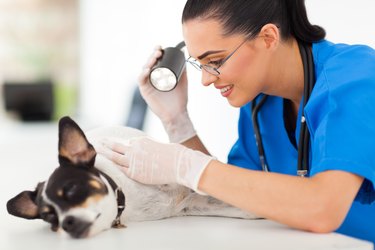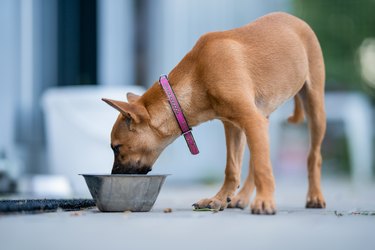A healthy dog has a clean and glossy coat. So, when dogs develop dry, itchy skin or greasy fur, it is a sign that you need to visit your veterinarian. Seborrhea in dogs may be genetic or secondary to another disease. If your dog is diagnosed with seborrhea, it may indicate that your dog has other serious health issues that need to be diagnosed and treated.

Video of the Day
What is seborrhea in dogs?
Seborrheic dermatitis, commonly referred to as seborrhea, is a skin disease that occurs due to the overproduction of sebum from a dog's sebaceous glands. Seborrhea can cause defective keratinization, the renewal process of the material that makes up the outer layer of skin, hair, and claws. This results in dry, scaly, flaky skin and often an oily coat.
Video of the Day
Types of seborrhea in dogs
There are two types of seborrhea in dogs. Dogs with seborrheic dermatitis usually have a combination of both types, and these are:
- Seborrhea sicca: Known as dry seborrhea, this type of seborrhea can affect any dog and results from a buildup of keratinized tissue. As the tissue flakes away, it can make the skin dry and scaly.
- Seborrhea oleosa: Also called oily seborrhea, this type of seborrhea is caused by an overproduction of sebum, which makes a dog's skin and fur appear greasy.

Causes of seborrhea in dogs
Seborrhea can be either a primary disease, meaning that it is genetic, or a secondary disease with underlying causes. Dog breeds with a genetic predisposition to primary seborrhea include American cocker spaniels, English springer spaniels, West Highland white terriers, and dachshunds.
Sometimes, no cause can be found for seborrhea in a dog. In this case, it is called idiopathic seborrhea. Your veterinarian will need to examine your dog to diagnose the type of seborrhea your dog has.
Secondary seborrheic dermatitis is the most common form of this skin disorder in dogs and is a symptom of an underlying disease. Here are some of the causes of seborrhea in dogs:
- Bacterial infections: Bacterial infections are common in seborrheic dermatitis in dogs. They can cause seborrhea, or they can be a secondary issue. This is because the condition of seborrheic skin is often vulnerable, and there may be trauma caused by the dog itching, licking, or chewing the area. Red pimples or pustules on the skin may indicate a bacterial infection.
- Fungal infections: Seborrhea is often associated with yeast infections in dogs. When the naturally occurring yeast Malassezia pachydermatis overgrows, it can cause hair loss and itching. It can also affect the ears. Ringworm is another fungus known to cause seborrhea in dogs. Dogs who have a fungal infection with their seborrhea will often have a distinctive odor.
- Parasite infections: Skin parasites, such as fleas, ticks, and mange mites, can cause excessive itching and trigger seborrhea. The more the dog scratches, the worse the condition gets.
- Hormonal imbalances: Endocrinal disorders that affect a dog's hormones, such as thyroid imbalances, Cushing's disease, or even diabetes, can cause seborrhea in dogs.
- Environmental factors: Some dogs have skin that is very sensitive to environmental conditions. A change in weather, temperature, or humidity can trigger seborrhea. Moving to a new home or starting to use heating or air conditioning can also be a factor.
- Dietary imbalances: A diet deficient in certain vitamins or essential fatty acids, such as omega-3, can lead to secondary seborrhea in dogs.
- Allergies: Allergies are one of the most common causes of dog seborrhea. Allergic responses to external causes may cause itching, which can quickly lead to seborrhea. In some cases, food allergies have also been diagnosed as a trigger for seborrhea.
- Obesity: If a dog is overweight, they may develop folds of skin that create perfect conditions for yeast and bacteria to cause seborrhea. It also makes it difficult for them to groom themself effectively.
- Pain: If a dog is suffering from a musculoskeletal disease, such as arthritis or hip dysplasia, especially if they are older, they may have difficulty with self-grooming or overgrooming. This can set off seborrhea, so red inflamed areas may appear along with dandruff and oily fur.
- Stress: Stress and skin issues are often related. When a dog is stressed, they may lick, chew, or scratch excessively. This can lead to damaged skin, allowing seborrhea and related infections to set in.
- Cancer: Cancers that affect a dog's autoimmune system, endocrinal system, or skin can cause seborrheic dermatitis.
Symptoms of seborrhea in dogs
Symptoms of seborrhea are most often found along a dog's back, in their paws, on their face, in their armpits, under their tail, and on their belly. Seborrhea can also appear in the skin folds of dogs with a lot of saggy or excess skin.
These symptoms indicate that your dog may have seborrhea and should be seen by a veterinarian.
- Dandruff
- Dry, flaky skin
- Redness
- Inflammation
- Red pimples or pustules
- Rough, crusted skin lesions
- Dull coat
- Greasy fur
- Fur loss
- Oily skin
- Odor

Treatment of seborrhea in dogs
Your veterinarian will examine your dog and undertake diagnostic tests to identify the cause and type of your dog's seborrhea. This may include skin scrapings, cultures, or biopsies as well as blood and hormone tests. Once your dog has been diagnosed, your veterinarian will outline a treatment plan.
Sometimes, you can do things to assist your veterinarian and make your dog more comfortable.
Food sensitivity
If you suspect your dog has a food sensitivity, you can try a process of elimination to determine if any particular item is causing the skin problems. For instance, dogs can develop an allergy to commercial dog food. If you see no improvement after 12 weeks, request further guidance from your veterinarian.
Other sensitivities
Environmental factors and other substances can trigger allergic responses leading to seborrhea in dogs. Ingredients in shampoos, flea medications, plants, and even fabrics can cause allergies. Eliminate any substances or products recently introduced to the dog's environment. If you see no improvement within 14 days, consult your veterinarian.
Moisturizing
Use veterinarian-recommended pet moisturizers to alleviate dryness and reduce itching in mild cases. If the dog scratches less, the irritation leading to seborrhea may be relieved. Take your dog to the veterinarian if you see any pustules, lesions, sores, inflammation, or redness.
Coal tar
Coal tar is commonly used by people for treating itchy skin problems and can be used for dogs as well. Only use tar shampoos formulated for dogs.
Sulfur
In cases of dry and scaly seborrhea, sulfur or salicylic acid medicated shampoos for dogs help remove scale formation on the skin to aid healing and reduce discomfort.

How do veterinarians treat canine seborrhea?
Once a veterinarian has diagnosed the cause of canine seborrheic dermatitis, they will first address any symptoms, such as infection, itchiness, soreness, and discomfort, and will then treat the underlying cause.
Antibiotics or anti-fungals may be prescribed to deal with bacterial or yeast infections. If it is primary seborrhea, managing the skin disorder will be an essential part of caring for the dog, and your veterinarian will discuss the best way to do this.
If the seborrhea is secondary, treatments will be recommended depending on the underlying problem. If the cause is skin parasites, then a treatment and prevention plan will be implemented. Dietary changes may be necessary, and if the dog is obese, this will need to be worked on. If the dog has any pain or discomfort, appropriate anti-inflammatories and pain relief will be given. Dogs with hormonal imbalances or cancer will have to undergo therapeutic treatment and close monitoring.
The bottom line
While dandruff or greasy fur may not seem serious for your dog, it can quickly develop into sore, hairless, itchy areas. These are not only uncomfortable for the dog but they can also be a sign of serious medical problems. A dog's fur is a good indicator of health, so a dull coat, bald patches, or itchy and sore skin are all signs that the dog should see a veterinarian. Catching the problem early may also prevent secondary bacterial or fungal infections.